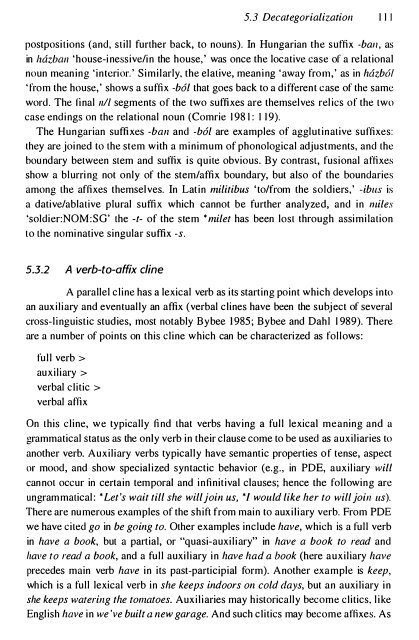Gram - SEAS
Gram - SEAS
Gram - SEAS
Create successful ePaper yourself
Turn your PDF publications into a flip-book with our unique Google optimized e-Paper software.
5.3 Decategorialization I I I<br />
postpositions (and, still further back, to nouns). In Hungarian the suffix -ball, as<br />
in luizball 'house-inessive/in the house,' was once the locative case of a relational<br />
noun meaning 'interior.' Similarly, the elative, meaning 'away from,' as in hazbol<br />
'from the house,' shows a suffix -bol that goes back to a different case of the same<br />
word. The final 1111 segments of the two suffixes are themselves relics of the two<br />
case endi ngs on the relational noun (Comrie 1981: I 19).<br />
The Hungarian suffixes -ban and -bol are examples of agglutinative suffixes:<br />
they are joined to the stem with a minimum of phonological adjustments, and the<br />
boundary between stem and sutTix is quite obvious. By contrast, fusional affixes<br />
show a blurring not only of the stem/affix boundary, but also of the boundaries<br />
among the affixes themselves. In Latin militibus 'to/from the soldiers,' -ibm; is<br />
a dative/ablative plural suffix which cannot be further analyzed, and in miles<br />
'soldier:NOM:SG' the -t- of the stem *milet has been lost through assimilation<br />
to the nominative singular suffix -so<br />
5.3.2 A verb-ta-affix cline<br />
A parallel cline has a lexical verb as its starting point which develops into<br />
an auxiliary and eventually an affix (verbal clines have been the subject of several<br />
cross-linguistic studies, most notably Bybee 1985; Bybee and Dahl 1989). There<br />
are a number of points on this cline which can be characterized as follows:<br />
fu ll verb ><br />
auxiliary ><br />
verbal c1itic ><br />
verbal affix<br />
On this cline, we typically find that verbs having a fu ll lexical meaning and a<br />
grammatical status as the only verb in their clause come to be used as auxiliaries to<br />
another verb. Auxiliary verbs typically have semantic properties of tense, aspect<br />
or mood, and show specialized syntactic behavior (e.g., in POE, auxiliary will<br />
cannot occur in certain temporal and infinitival clauses; hence the following are<br />
ungrammatical: * Let's wait till she will join us, */ would like her to will joill us).<br />
There are numerous examples of the shift from main to auxiliary verb. From POE<br />
we have cited go in be going to. Other examples include have, which is a fu ll verb<br />
in have a book, but a partial, or "quasi-auxiliary" in have a book to read and<br />
have to read a book, and a fu ll auxiliary in have had a book (here auxiliary have<br />
precedes main verb have in its past-participial form). Another example is keep,<br />
wh ich is a fu ll lexical verb in she keeps indoors on cold days, but an auxiliary in<br />
she keeps watering the tomatoes. Auxiliaries may historically become c1itics, like<br />
English have in we 've built a new garage. And such c1itics may become affixes. As
















